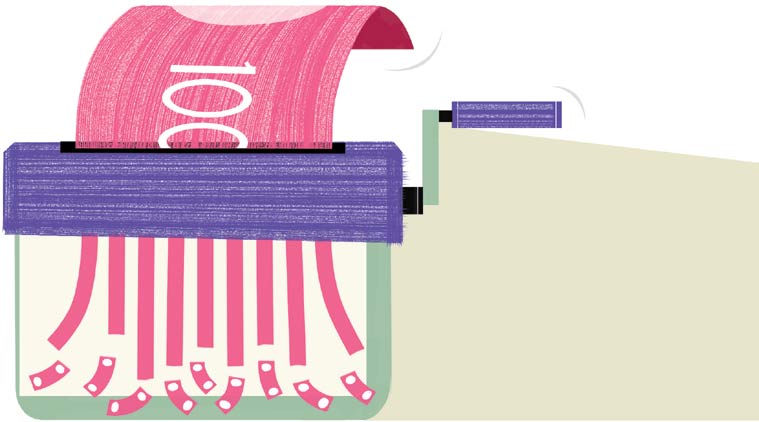Across the Aisle: Black to white magic
RBI had done no study or preparatory work; yet the Central Board of RBI hurriedly met on November 8, without an agenda and without a background note, and dutifully “recommended” that the notes may be declared no longer legal tender.

The Chief Economic Adviser was not consulted or taken into confidence.
Demonetisation is done but not yet dusted. With the release of the RBI’s Annual Report for 2017-18, the ghost of demonetisation has come back to haunt the government of Mr Narendra Modi.
A policy may be well-intended, yet flawed. In the case of demonetisation it is difficult to believe that the policy was well-intended because of the opaque process that was followed before the decision was announced. On November 7, 2016, the government told RBI to send its recommendation on the proposed demonetisation of currency (Rs 500 and Rs 1,000 notes) by the next day. RBI had done no study or preparatory work; yet the Central Board of RBI hurriedly met on November 8, without an agenda and without a background note, and dutifully “recommended” that the notes may be declared no longer legal tender.
The Chief Economic Adviser was not consulted or taken into confidence: on November 8 he was in Kerala to deliver a talk.
A Note for Cabinet was not prepared and circulated to the Cabinet or tabled at the Cabinet meeting held on November 8. Ministers who were present have admitted, privately, that they were “told” at the meeting that currency will be demonetised.
Failed Objectives
Nevertheless, let me assume that the decision to demonetise currency was taken with the intention of achieving certain objectives — seizing black money, ending counterfeiting of currency notes and stopping the financing of terrorism. None of the objectives has been achieved: hoards of black (i.e. unaccounted) money in new currency notes continue to be seized; counterfeit currency in the new denominations and design continue to be detected; and terrorism continues unabated and is presumably financed by new currency notes.
In the light of the failed objectives, what should the people conclude on demonetisation? I shall reserve my conclusion for the end and look at one important outcome of demonetisation — its impact on saving, especially household saving.

More Cash, Less Saving
According to the RBI, currency in circulation on October 28, 2016 (before demonetisation) was of the value of Rs 17,54,022 crore. On August 17, 2018, the currency in circulation was Rs 19,17,129 crore! So, we are not a less-cash economy because of demonetisation. How is this currency in circulation accounted for? For the answer, see Table 1.
Some facts are self-evident:
1. The people of India trust cash. They are keeping more cash with them today than in 2015-16. The amount of cash in hand has actually doubled from 1.4 to 2.8 per cent. Consequently, cash in the form of deposits with banks has declined from 4.6 to 2.9 per cent.
2. People have borrowed more and their liabilities have increased from 2.8 to 4 per cent. As a result, while the gross household saving is higher, the net household saving has declined from 8.1 to 7.1 per cent.
3. The fall in net household saving has impacted investment measured by Gross Fixed Capital Formation (GFCF) and its components: see Table 2.

4. The fall in GFCF naturally affected the growth rate since demonetisation. It is too early to celebrate the 2018-19 Q1 growth rate of 8.2 per cent because it is on the lowest base of 5.6 per cent recorded in 16 quarters since the NDA came to power. Going forward, the ‘base effect’ will not be so favourable. Hence, even if the economy maintains its current pace of growth, the quarterly growth rate is likely to slide in the next three quarters.
Inventing Arguments
Given these facts, it is amusing to see the government’s spokespersons inventing new arguments to flaunt the ‘success’ of demonetisation.
The favourite argument is that the tax base has increased. True, a record 5.42 crore income tax returns have been filed in the current year. But, remember that 1 crore filers return ‘nil’ tax liability and pay no income tax! Besides, the increase in direct tax revenue is only 6.6 per cent against a budgeted increase of 14.4 per cent.
There is also the pie-in-the-sky argument: thousands of suspicious accounts and transactions are under scrutiny. Good, but when will the process, including appeals and further appeals, be completed? The government is counting its chicken before they are hatched. Meanwhile, the public perception is that tax terrorism has been unleashed upon individuals and businesses.
The next argument is rapid digitisation. Between 2013-14 and 2017-18, the value of digital transactions has increased annually at 14.3, 10.7, 9.1, 24.4 and 12 per cent, indicating no acceleration in the pace because of demonetisation. Moreover, digitisation has been achieved in other countries without the disruption and pain of demonetisation and could have been achieved in India too.
At the end of the day, after being told that Rs 15,31,000 crore has been returned to the RBI, the general perception is that demonetisation was an ingenious device to facilitate a number of people to convert their black money into white money through a simple over-the-counter exchange at banks! Elementary, Dr Watson!
For all the latest Opinion News, download Indian Express App
More From P Chidambaram
- Across the Aisle: Jobs- The make or break issueThe reality is that a loan of Rs 47,268 is not sufficient to create a job. That amount may be enough to buy some tools…
- Across the Aisle: Emulate, do not envyThe first year was promising and the second year too started well. The first major blunder was demonetisation on November 8, 2016. This was followed…
- Across the aisle: Mr A B Vajpayee, RIPTo most of his party colleagues and the RSS, he was the right man to lead the ‘right’ party. To many belonging to other parties,…







































No hay comentarios:
Publicar un comentario